Business Strategy Analysis: A Case Study on Macy's Performance
VerifiedAdded on 2023/01/18
|5
|991
|39
Case Study
AI Summary
This case study analyzes Macy's, Inc., examining its historical background, mission, and vision statements. It evaluates Macy's current mission statement, proposes a revised version, and presents a vision statement. The study further applies Porter's Five Forces to analyze the competitive environment, considering factors like rivalry among firms, potential new entrants, substitute products, supplier power, and customer bargaining power within the department store industry. The analysis highlights Macy's critical milestones, market position, and strategic challenges, providing a comprehensive overview of the company's business development and competitive strategy.
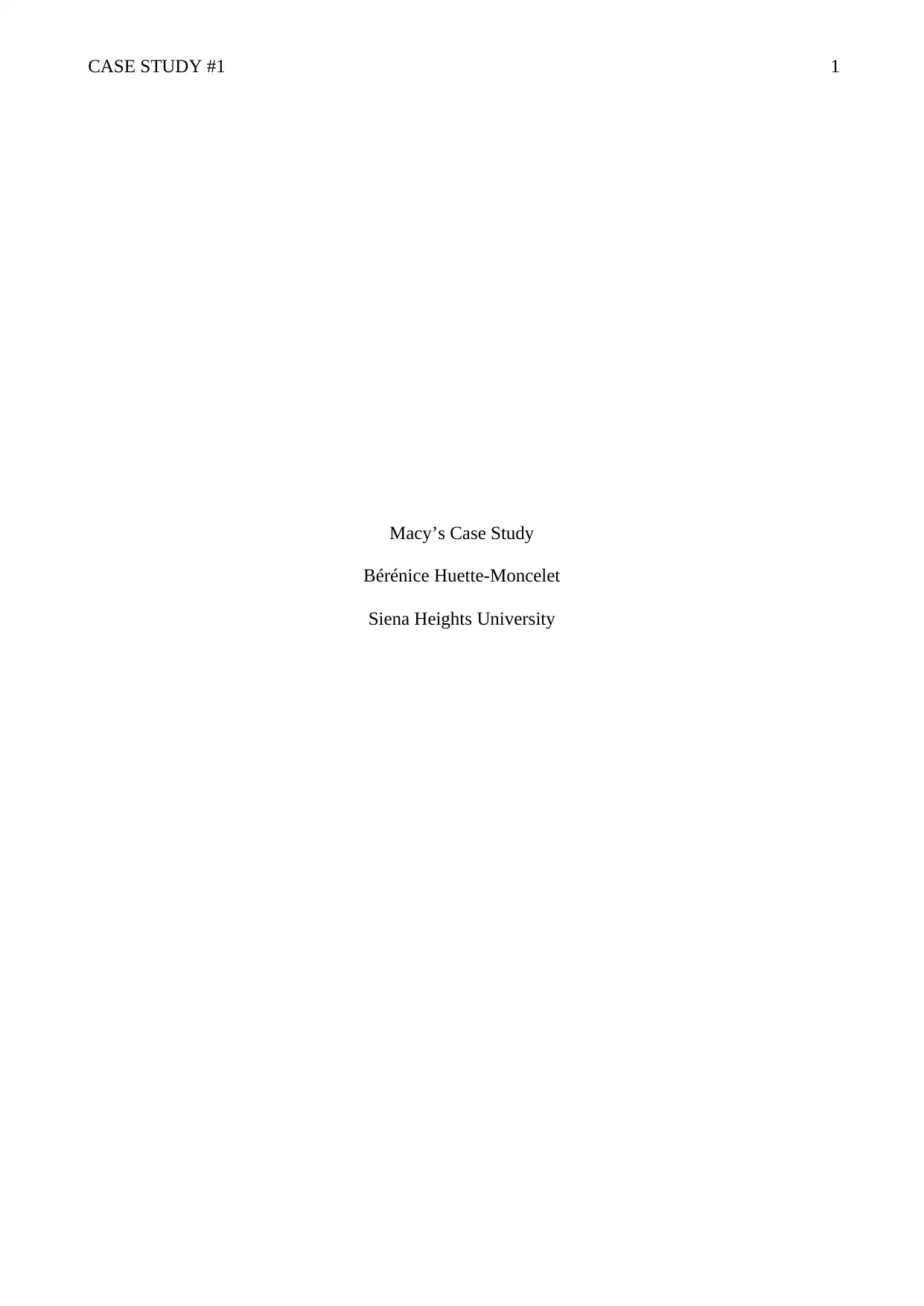
CASE STUDY #1 1
Macy’s Case Study
Bérénice Huette-Moncelet
Siena Heights University
Macy’s Case Study
Bérénice Huette-Moncelet
Siena Heights University
Paraphrase This Document
Need a fresh take? Get an instant paraphrase of this document with our AI Paraphraser
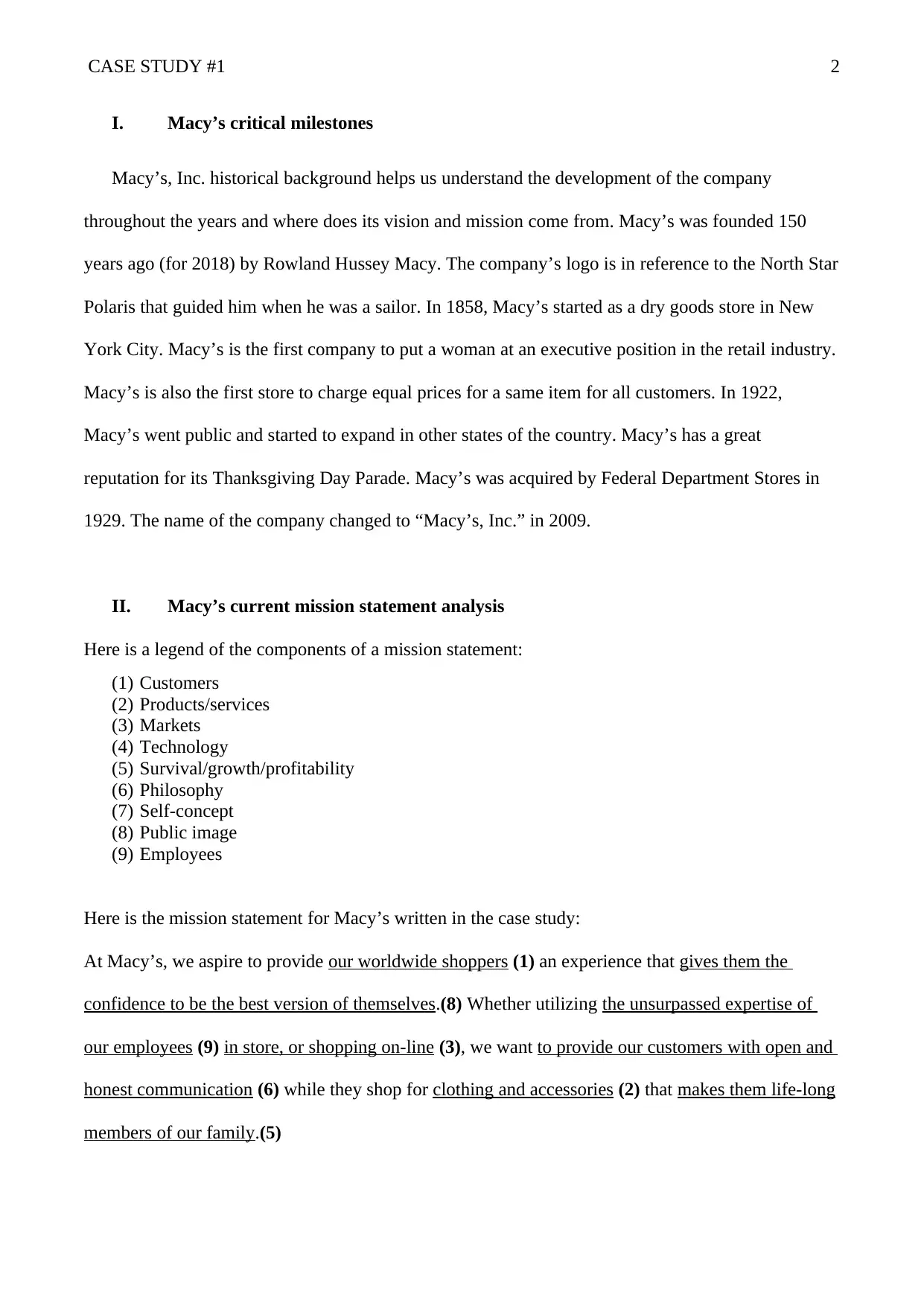
CASE STUDY #1 2
I. Macy’s critical milestones
Macy’s, Inc. historical background helps us understand the development of the company
throughout the years and where does its vision and mission come from. Macy’s was founded 150
years ago (for 2018) by Rowland Hussey Macy. The company’s logo is in reference to the North Star
Polaris that guided him when he was a sailor. In 1858, Macy’s started as a dry goods store in New
York City. Macy’s is the first company to put a woman at an executive position in the retail industry.
Macy’s is also the first store to charge equal prices for a same item for all customers. In 1922,
Macy’s went public and started to expand in other states of the country. Macy’s has a great
reputation for its Thanksgiving Day Parade. Macy’s was acquired by Federal Department Stores in
1929. The name of the company changed to “Macy’s, Inc.” in 2009.
II. Macy’s current mission statement analysis
Here is a legend of the components of a mission statement:
(1) Customers
(2) Products/services
(3) Markets
(4) Technology
(5) Survival/growth/profitability
(6) Philosophy
(7) Self-concept
(8) Public image
(9) Employees
Here is the mission statement for Macy’s written in the case study:
At Macy’s, we aspire to provide our worldwide shoppers (1) an experience that gives them the
confidence to be the best version of themselves.(8) Whether utilizing the unsurpassed expertise of
our employees (9) in store, or shopping on-line (3), we want to provide our customers with open and
honest communication (6) while they shop for clothing and accessories (2) that makes them life-long
members of our family.(5)
I. Macy’s critical milestones
Macy’s, Inc. historical background helps us understand the development of the company
throughout the years and where does its vision and mission come from. Macy’s was founded 150
years ago (for 2018) by Rowland Hussey Macy. The company’s logo is in reference to the North Star
Polaris that guided him when he was a sailor. In 1858, Macy’s started as a dry goods store in New
York City. Macy’s is the first company to put a woman at an executive position in the retail industry.
Macy’s is also the first store to charge equal prices for a same item for all customers. In 1922,
Macy’s went public and started to expand in other states of the country. Macy’s has a great
reputation for its Thanksgiving Day Parade. Macy’s was acquired by Federal Department Stores in
1929. The name of the company changed to “Macy’s, Inc.” in 2009.
II. Macy’s current mission statement analysis
Here is a legend of the components of a mission statement:
(1) Customers
(2) Products/services
(3) Markets
(4) Technology
(5) Survival/growth/profitability
(6) Philosophy
(7) Self-concept
(8) Public image
(9) Employees
Here is the mission statement for Macy’s written in the case study:
At Macy’s, we aspire to provide our worldwide shoppers (1) an experience that gives them the
confidence to be the best version of themselves.(8) Whether utilizing the unsurpassed expertise of
our employees (9) in store, or shopping on-line (3), we want to provide our customers with open and
honest communication (6) while they shop for clothing and accessories (2) that makes them life-long
members of our family.(5)
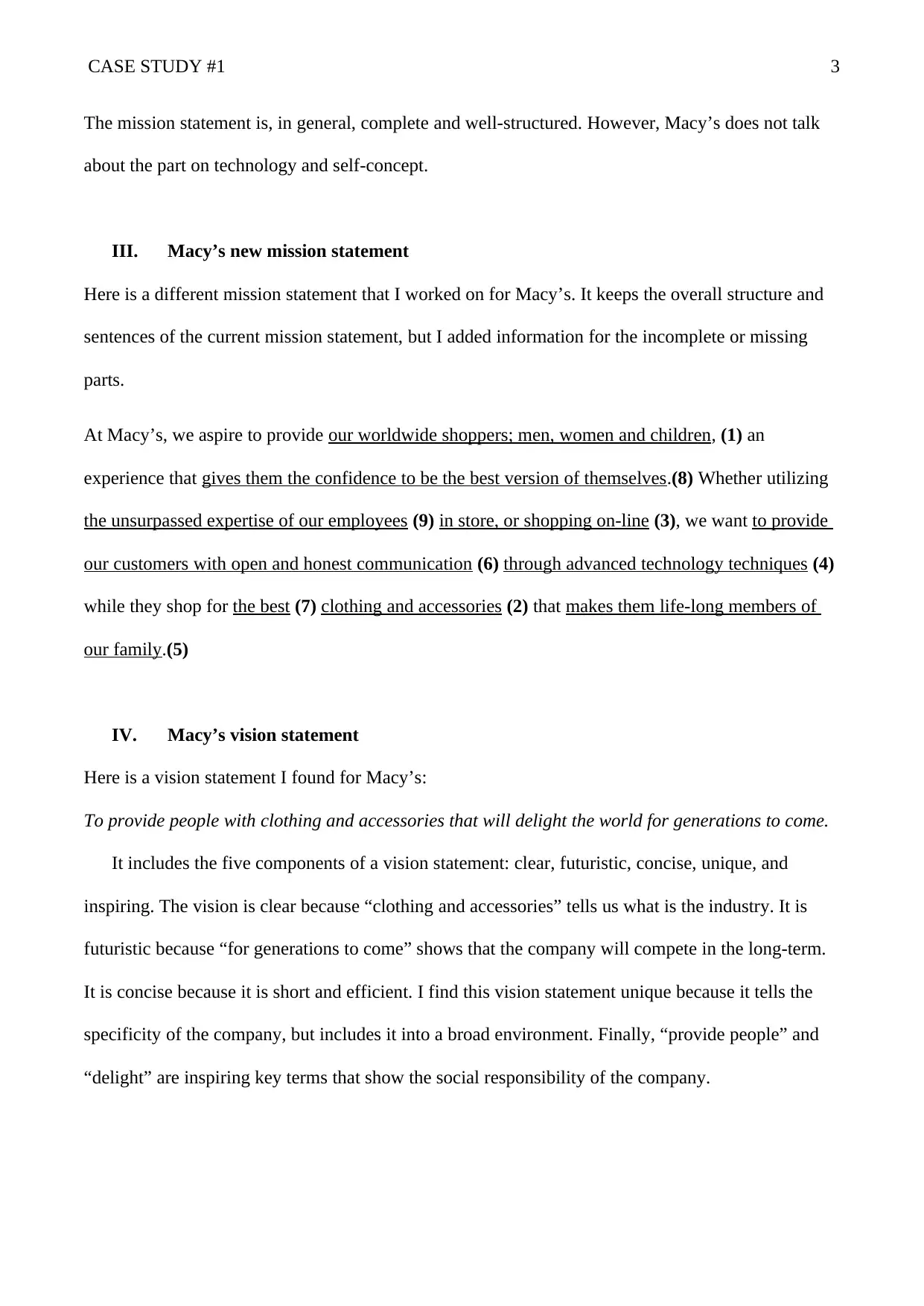
CASE STUDY #1 3
The mission statement is, in general, complete and well-structured. However, Macy’s does not talk
about the part on technology and self-concept.
III. Macy’s new mission statement
Here is a different mission statement that I worked on for Macy’s. It keeps the overall structure and
sentences of the current mission statement, but I added information for the incomplete or missing
parts.
At Macy’s, we aspire to provide our worldwide shoppers; men, women and children, (1) an
experience that gives them the confidence to be the best version of themselves.(8) Whether utilizing
the unsurpassed expertise of our employees (9) in store, or shopping on-line (3), we want to provide
our customers with open and honest communication (6) through advanced technology techniques (4)
while they shop for the best (7) clothing and accessories (2) that makes them life-long members of
our family.(5)
IV. Macy’s vision statement
Here is a vision statement I found for Macy’s:
To provide people with clothing and accessories that will delight the world for generations to come.
It includes the five components of a vision statement: clear, futuristic, concise, unique, and
inspiring. The vision is clear because “clothing and accessories” tells us what is the industry. It is
futuristic because “for generations to come” shows that the company will compete in the long-term.
It is concise because it is short and efficient. I find this vision statement unique because it tells the
specificity of the company, but includes it into a broad environment. Finally, “provide people” and
“delight” are inspiring key terms that show the social responsibility of the company.
The mission statement is, in general, complete and well-structured. However, Macy’s does not talk
about the part on technology and self-concept.
III. Macy’s new mission statement
Here is a different mission statement that I worked on for Macy’s. It keeps the overall structure and
sentences of the current mission statement, but I added information for the incomplete or missing
parts.
At Macy’s, we aspire to provide our worldwide shoppers; men, women and children, (1) an
experience that gives them the confidence to be the best version of themselves.(8) Whether utilizing
the unsurpassed expertise of our employees (9) in store, or shopping on-line (3), we want to provide
our customers with open and honest communication (6) through advanced technology techniques (4)
while they shop for the best (7) clothing and accessories (2) that makes them life-long members of
our family.(5)
IV. Macy’s vision statement
Here is a vision statement I found for Macy’s:
To provide people with clothing and accessories that will delight the world for generations to come.
It includes the five components of a vision statement: clear, futuristic, concise, unique, and
inspiring. The vision is clear because “clothing and accessories” tells us what is the industry. It is
futuristic because “for generations to come” shows that the company will compete in the long-term.
It is concise because it is short and efficient. I find this vision statement unique because it tells the
specificity of the company, but includes it into a broad environment. Finally, “provide people” and
“delight” are inspiring key terms that show the social responsibility of the company.
⊘ This is a preview!⊘
Do you want full access?
Subscribe today to unlock all pages.

Trusted by 1+ million students worldwide
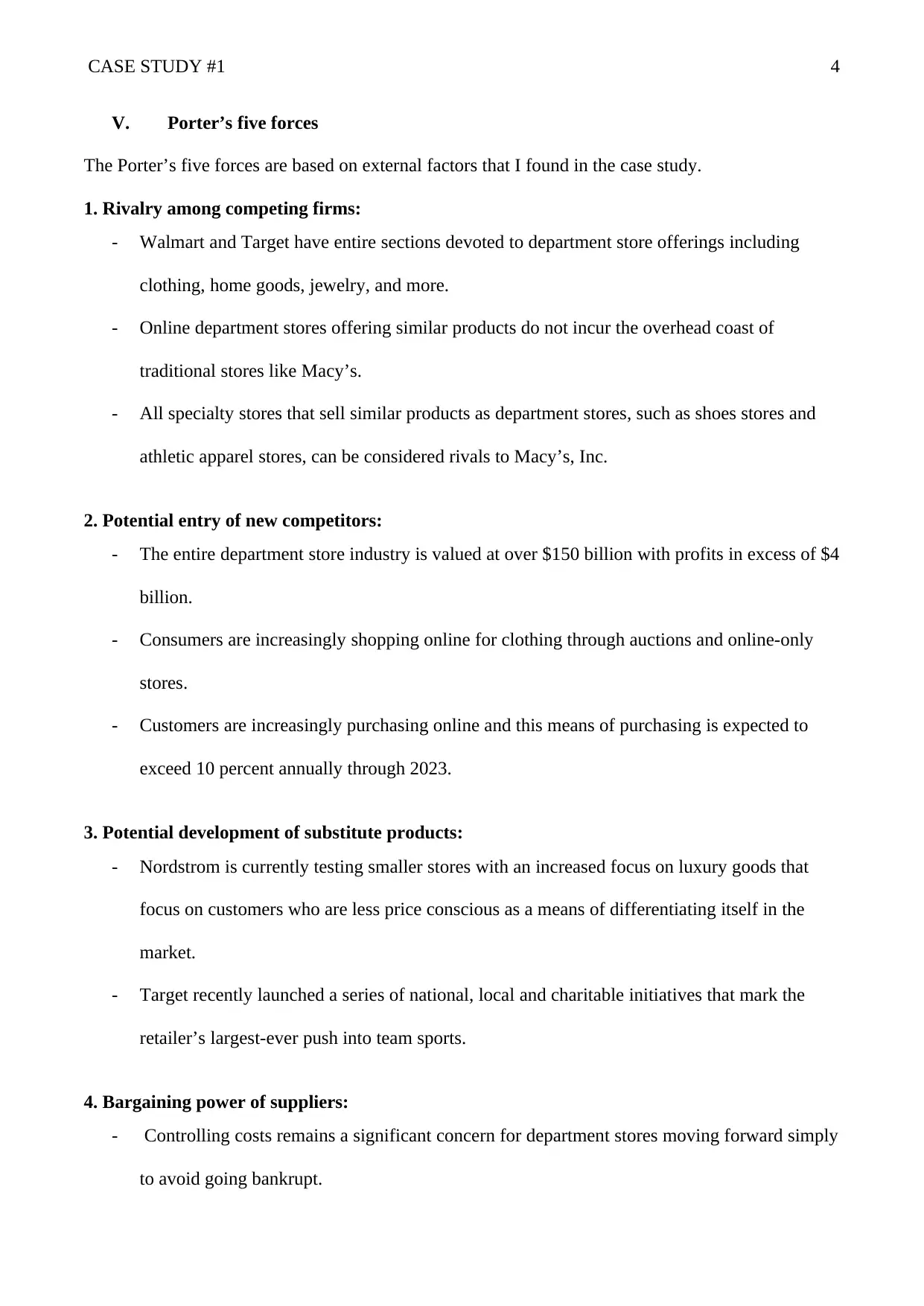
CASE STUDY #1 4
V. Porter’s five forces
The Porter’s five forces are based on external factors that I found in the case study.
1. Rivalry among competing firms:
- Walmart and Target have entire sections devoted to department store offerings including
clothing, home goods, jewelry, and more.
- Online department stores offering similar products do not incur the overhead coast of
traditional stores like Macy’s.
- All specialty stores that sell similar products as department stores, such as shoes stores and
athletic apparel stores, can be considered rivals to Macy’s, Inc.
2. Potential entry of new competitors:
- The entire department store industry is valued at over $150 billion with profits in excess of $4
billion.
- Consumers are increasingly shopping online for clothing through auctions and online-only
stores.
- Customers are increasingly purchasing online and this means of purchasing is expected to
exceed 10 percent annually through 2023.
3. Potential development of substitute products:
- Nordstrom is currently testing smaller stores with an increased focus on luxury goods that
focus on customers who are less price conscious as a means of differentiating itself in the
market.
- Target recently launched a series of national, local and charitable initiatives that mark the
retailer’s largest-ever push into team sports.
4. Bargaining power of suppliers:
- Controlling costs remains a significant concern for department stores moving forward simply
to avoid going bankrupt.
V. Porter’s five forces
The Porter’s five forces are based on external factors that I found in the case study.
1. Rivalry among competing firms:
- Walmart and Target have entire sections devoted to department store offerings including
clothing, home goods, jewelry, and more.
- Online department stores offering similar products do not incur the overhead coast of
traditional stores like Macy’s.
- All specialty stores that sell similar products as department stores, such as shoes stores and
athletic apparel stores, can be considered rivals to Macy’s, Inc.
2. Potential entry of new competitors:
- The entire department store industry is valued at over $150 billion with profits in excess of $4
billion.
- Consumers are increasingly shopping online for clothing through auctions and online-only
stores.
- Customers are increasingly purchasing online and this means of purchasing is expected to
exceed 10 percent annually through 2023.
3. Potential development of substitute products:
- Nordstrom is currently testing smaller stores with an increased focus on luxury goods that
focus on customers who are less price conscious as a means of differentiating itself in the
market.
- Target recently launched a series of national, local and charitable initiatives that mark the
retailer’s largest-ever push into team sports.
4. Bargaining power of suppliers:
- Controlling costs remains a significant concern for department stores moving forward simply
to avoid going bankrupt.
Paraphrase This Document
Need a fresh take? Get an instant paraphrase of this document with our AI Paraphraser
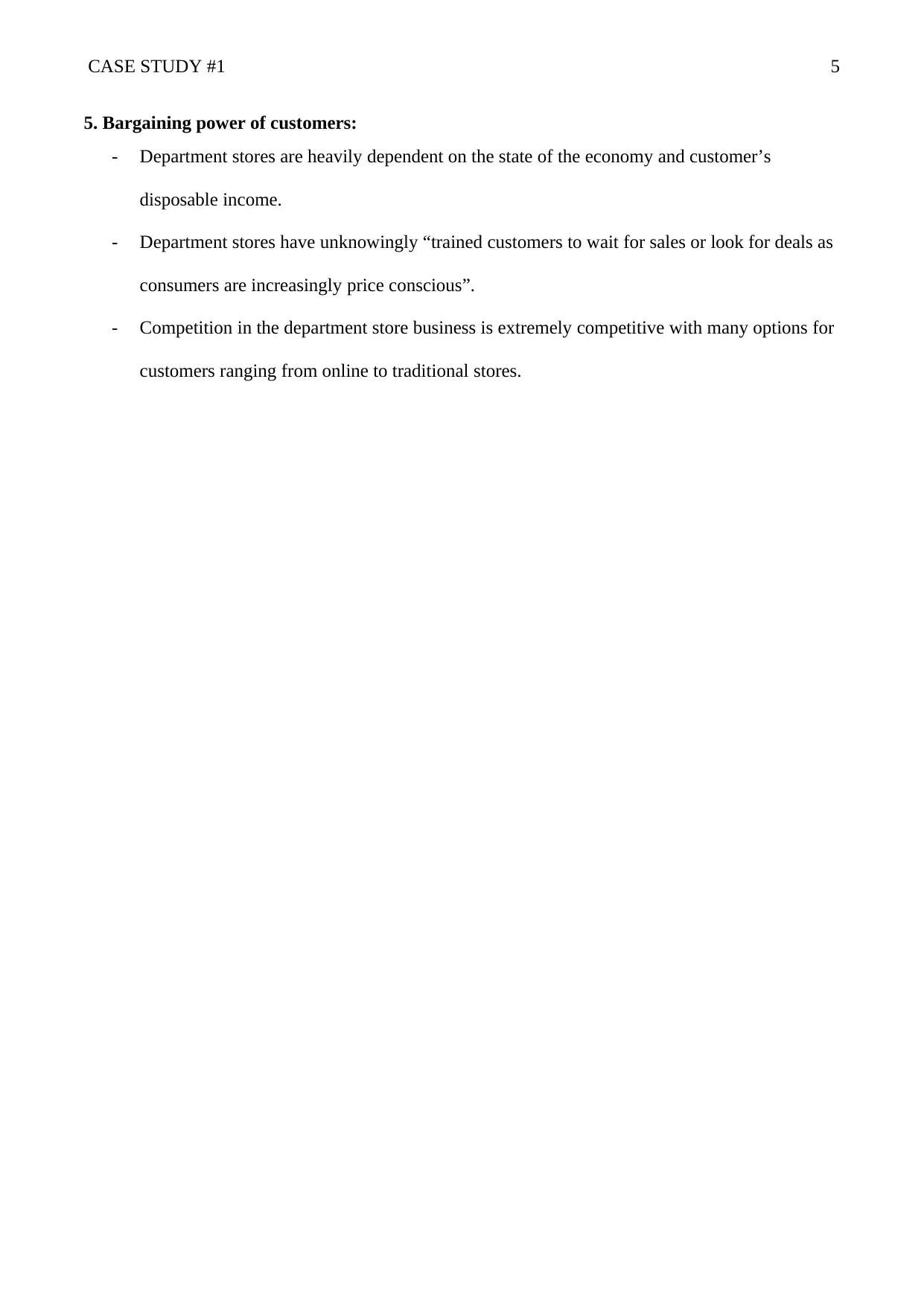
CASE STUDY #1 5
5. Bargaining power of customers:
- Department stores are heavily dependent on the state of the economy and customer’s
disposable income.
- Department stores have unknowingly “trained customers to wait for sales or look for deals as
consumers are increasingly price conscious”.
- Competition in the department store business is extremely competitive with many options for
customers ranging from online to traditional stores.
5. Bargaining power of customers:
- Department stores are heavily dependent on the state of the economy and customer’s
disposable income.
- Department stores have unknowingly “trained customers to wait for sales or look for deals as
consumers are increasingly price conscious”.
- Competition in the department store business is extremely competitive with many options for
customers ranging from online to traditional stores.
1 out of 5
Your All-in-One AI-Powered Toolkit for Academic Success.
+13062052269
info@desklib.com
Available 24*7 on WhatsApp / Email
![[object Object]](/_next/static/media/star-bottom.7253800d.svg)
Unlock your academic potential
Copyright © 2020–2025 A2Z Services. All Rights Reserved. Developed and managed by ZUCOL.